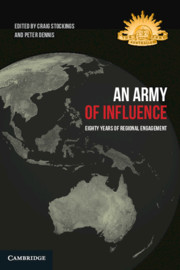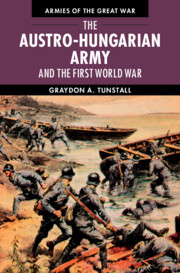Refine search
Actions for selected content:
15366 results in Military history
10 - Russia’s Air War Win in Syria
-
-
- Book:
- Air Power in the Age of Primacy
- Published online:
- 16 December 2021
- Print publication:
- 16 December 2021, pp 229-254
-
- Chapter
- Export citation
Figures
-
- Book:
- Air Power in the Age of Primacy
- Published online:
- 16 December 2021
- Print publication:
- 16 December 2021, pp vii-vii
-
- Chapter
- Export citation
Index
-
- Book:
- Air Power in the Age of Primacy
- Published online:
- 16 December 2021
- Print publication:
- 16 December 2021, pp 306-316
-
- Chapter
- Export citation
Preface and Acknowledgements
-
- Book:
- The Malayan Emergency
- Published online:
- 16 December 2021
- Print publication:
- 16 December 2021, pp xi-xiii
-
- Chapter
- Export citation
12 - Retrospect and Prospect: Air Power in the Age of Primacy and Beyond
-
-
- Book:
- Air Power in the Age of Primacy
- Published online:
- 16 December 2021
- Print publication:
- 16 December 2021, pp 279-305
-
- Chapter
- Export citation
Bibliography
-
- Book:
- The Malayan Emergency
- Published online:
- 16 December 2021
- Print publication:
- 16 December 2021, pp 469-489
-
- Chapter
- Export citation
6 - Chin Peng and Communist Plans
-
- Book:
- The Malayan Emergency
- Published online:
- 16 December 2021
- Print publication:
- 16 December 2021, pp 247-286
-
- Chapter
- Export citation
Abbreviations
-
- Book:
- Air Power in the Age of Primacy
- Published online:
- 16 December 2021
- Print publication:
- 16 December 2021, pp xv-xviii
-
- Chapter
- Export citation

An Army of Influence
- Eighty Years of Regional Engagement
-
- Published online:
- 16 November 2021
- Print publication:
- 22 October 2021

The Austro-Hungarian Army and the First World War
-
- Published online:
- 10 November 2021
- Print publication:
- 30 September 2021
Frontmatter
-
- Book:
- Guided Missile Frigate Tromp
- Published by:
- Amsterdam University Press
- Published online:
- 27 March 2024
- Print publication:
- 25 October 2021, pp 1-1
-
- Chapter
- Export citation
Replacing the Cruisers
-
- Book:
- Guided Missile Frigate Tromp
- Published by:
- Amsterdam University Press
- Published online:
- 27 March 2024
- Print publication:
- 25 October 2021, pp 2-2
-
- Chapter
- Export citation
Introduction
-
- Book:
- Guided Missile Frigate Tromp
- Published by:
- Amsterdam University Press
- Published online:
- 27 March 2024
- Print publication:
- 25 October 2021, pp 3-72
-
- Chapter
- Export citation
Chapter 16 - The Army’s patchy engagement with Australia’s near north
- from Part 3 - Ongoing relationships
-
-
- Book:
- An Army of Influence
- Published online:
- 16 November 2021
- Print publication:
- 22 October 2021, pp 361-386
-
- Chapter
- Export citation
Chapter 15 - A perspective on diplomacy in the Army’s contemporary regional relationship-building
- from Part 3 - Ongoing relationships
-
-
- Book:
- An Army of Influence
- Published online:
- 16 November 2021
- Print publication:
- 22 October 2021, pp 345-360
-
- Chapter
- Export citation
Contents
-
- Book:
- An Army of Influence
- Published online:
- 16 November 2021
- Print publication:
- 22 October 2021, pp vii-viii
-
- Chapter
- Export citation
Chapter 9 - Access, but how much influence?
- from Part 3 - Ongoing relationships
-
-
- Book:
- An Army of Influence
- Published online:
- 16 November 2021
- Print publication:
- 22 October 2021, pp 186-219
-
- Chapter
- Export citation
Chapter 6 - Helping the Americans help the Vietnamese?
- from Part 2 - Lessons from past relationships
-
-
- Book:
- An Army of Influence
- Published online:
- 16 November 2021
- Print publication:
- 22 October 2021, pp 115-139
-
- Chapter
- Export citation
Chapter 12 - Was the juice worth the squeeze?
- from Part 3 - Ongoing relationships
-
-
- Book:
- An Army of Influence
- Published online:
- 16 November 2021
- Print publication:
- 22 October 2021, pp 267-299
-
- Chapter
- Export citation
Chapter 2 - The Australian Army through the lens of Australian defence white papers since 1976
- from Part 1 - The concept of an army’s influence abroad
-
-
- Book:
- An Army of Influence
- Published online:
- 16 November 2021
- Print publication:
- 22 October 2021, pp 38-51
-
- Chapter
- Export citation
